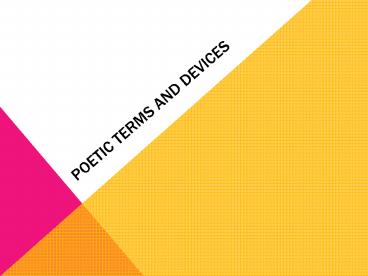Poetic Terms and Devices - PowerPoint PPT Presentation
1 / 19
Title:
Poetic Terms and Devices
Description:
POETIC TERMS AND DEVICES SPEAKER The speaker is the voice of a poem. ... FIGURATIVE LANGUAGE Figurative language is writing or speech not meant to be taken literally. – PowerPoint PPT presentation
Number of Views:316
Avg rating:3.0/5.0
Title: Poetic Terms and Devices
1
Poetic Terms and Devices
2
SPEAKER
- The speaker is the voice of a poem.
- The speaker is often the poet, however.
- It may be a fictional character or even an
inanimate object or other nonhuman entity. - Understanding and interpreting a poem often
depends upon recognizing who the speaker is, whom
the speaker is addressing, and what the speakers
attitude, or tone is.
3
Diction
- Diction is a writers or speakers word choice.
- It is part of a writers style and may be
described as formal or informal, plain or ornate,
common or technical, abstract or concrete. - EX
4
COMPAre
- Connotation
- denotation
- An association that a word calls to mind in
addition to the dictionary meaning of the word.
- The objective meaning of a word, independent of
other associations that the word brings to mind.
Many words that are similar in their dictionary
meanings (denotations) are very different in
their connotations. For example, Jose Garcia
Villas line, Be beautiful, noble, like the
antique ant, would have a very different effect
if it were, Be pretty, classy, like the old
ant. Why? What do these two sets of words bring
to mind?
5
Figurative Language
- Figurative language is writing or speech not
meant to be taken literally. - Used to express ideas in vivid or imaginative
ways. - Example Emily Dickinson begins one poem with the
following description of snow - It sifts from leaden sieves,
- It powders all the wood.
- By describing the snow as if it were flour, she
gives us a precise and compelling picture of it.
6
Comparisons
- Simile
- metaphor
- A figure of speech that makes a comparison
between two subjects using either like or as.
- A figure of speech in which one thing is spoken
of as though it were something else it suggests
a comparison between the two things that are
identified.
7
Personification
- When an animal, object, force of nature, or idea
is given human qualities or characteristics. - Example Edgar Lee Masters uses personification
in his poem Rain in My Heart - And memory sleeps beneath the gray
- And windless sky
8
Symbol
- An object, person, place or experience that
represents something else, usually something
abstract. - May have more than one meaning.
- May change between the beginning and the end of a
work.
9
Rhythm and Meter
- Rhythm
- The pattern of sound created by the arrangement
of stressed and unstressed syllables. - Can emphasize ceratin words or ideas and give
poetry a musical quality that will help convey
meaning. - Can be regular or irregular.
- Example Man and boy stood cheering by,
- And home we brought you
shoulder-high. - Meter
- A regular pattern of stressed and unstressed
syllables that gives a line of poetry a
predictable rhythm. - The basic unit of meter is the foot.
10
Rhyme
- Rhyme
- The repetition of the same stressed vowel sounds
and any succeeding sounds in two or more words. - Internal Rhyme
- Occurs within a line
- End Rhyme
- Occurs at the end of lines.
- Rhyme Scheme
- The pattern of the end rhymes.
- May be designated by assigning a different letter
of the alphabet to each new rhyme.
11
Onomatopoeia
- The use of a word or phrase that imitates or
suggests the sound of what it describes.
The rusty spigot, sputters,
utters a splutter, spatters a
smattering of drops, gashes wider
slash, splatters, scatters, spurts,
finally stops sputtering and plash! gushes
rushes splashes clear water dashes. --Onomatopoei
a by Eve Miriam
12
Alliteration
- The repetition of sounds, most often consonant
sounds, at the beginnings of words. - Alliteration adds emphasis to words.
- The frogs frolicked fantastically.
- The wind whistled through the trees, whispering
softly.
13
Assonance
- The repetition of similar vowel sounds within
non-rhyming words, especially in a line of
poetry.
And so, all the night-tide, I lie down by the
side Of my darling, my darling, my life and my
bride. --Edgar Allan Poe, Annabel Lee
14
parallelism
- The use of a series of words, phrases, or
sentences that have similar grammatical form. - Emphasizes items that are arranged in similar
structures.
15
repetition
- Sounds, words, phrases, lines or stanzas are
repeated for emphasis. - Lends a sense of unity and continuity to the
writing.
16
structure
- The organization of images, ideas, words and
lines created through the use of rhythm, rhyme,
repetition or stanzas.
17
Sonnet
- A lyric poem of 14 lines, almost always written
in iambic pentameter and usually following strict
patterns of stanza division and rhyme. - Shakespeare
- Pablo Neruda
18
stanzas
- Octave
- 8 lines stanza or complete poem
- Sestet
- 6 line stanza or complete poem
- Quatrain
- 4 line stanza or complete poem.
- Couplet
- A pair of lines that work together as a unit and
usually rhyme.
19
Types of poetry
- Free Verse
- Poetry that has no fixed pattern of meter, line
length, or stanza arrangement - Lyric Poetry
- Expresses a speakers personal thoughts and
feelings usually short and musical - Narrative Poetry
- Verse that tells a story. It includes ballads,
epics, and shorter poems. - Dramatic Poetry
- Uses elements of drama. One or more characters
speak to themselves, other characters, or the
reader. It typically includes a tense situation
or emotional conflict.































